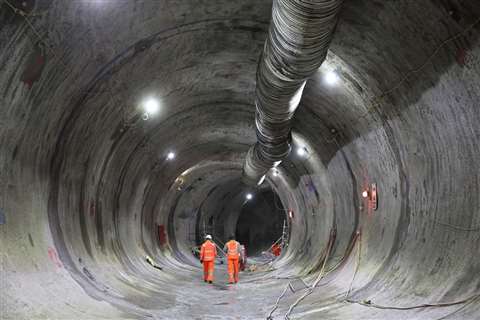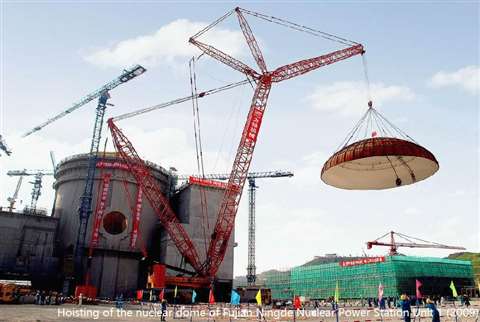Megaprojects: Two reasons why they go wrong (and four key ingredients for success)
20 June 2023
 A digital render of the high-speed rail line in California, US (Image: SENER)
A digital render of the high-speed rail line in California, US (Image: SENER)
As a construction project gets bigger, so do the stakes.
A whole host of factors can contrive to send work over time and over budget, with serious consequences for all involved.
In a worst case scenario contractors and clients can end up in legal disputes, there’s the risk of reputational damage, and projects can end up downscaled and even cancelled. Megaprojects (typically costing $1 billion or more) can find themselves subject to a whole new level of scrutiny.
And yet even when clients and their delivery teams are aware of the risks, things can and still do go wrong.
 Bent Flyvbjerg (Image supplied)
Bent Flyvbjerg (Image supplied)
Two of the most recent high-profile examples happen to be high-speed rail projects.
In the US, the cost of California’s high-speed rail system, expected to run 500 miles from Los Angeles to San Francisco, has ballooned to US$128 billion, up from last year’s estimate of $105 billion and faces a funding shortfall.
The first phase of the project, will run 171 miles from Merced to Bakersfield but the schedule even for that section has slipped from a solid completion date of 2030, to a window between 2030-33.
Meanwhile in the UK, the High Speed 2 line is now estimated to cost just over €80 billion (US$87 billion) – a significant hike from the estimate of €62.9 billion (S68.4 billion) in 2015. The government there has delayed the phase 2a of the project due to rising costs and the planned London terminus at Euston also faces delays and uncertainty, despite €332 million (US361.2 million) already being spent on the station’s design.
Given those projects’ troubles and their scale, scope and relative complexity, it’s tempting to suggest that high-speed rail is particularly prone to schedule and budget overruns.
But according to Bent Flyvbjerg, first BT professor at Oxford University and VKR professor at the IT University of Copenhagen, high-speed rail ranks somewhere in the middle in terms of megaprojects’ propensity to encounter such overruns.
Prof. Flyvberg claims to be the most cited scholar in the world on the subject of megaprojects and has written books on the subject, including How Big Things Get Done.
He and his colleagues have built up a database of 16,000 projects around the world to try to understand the differences between success and failure to inform the better management of megaprojects.
In his latest book, Flyvbjerg examines more than 20 different project types and finds that nuclear power projects, putting on the Olympics, and the construction of hydroelectric dams rank among some of the most problematic.
On the other end of the scale, roads projects tend to result in smaller cost overruns and delays, as do wind and solar projects where there is a high level of repeatability.
Two root causes of project failure
Regardless of project type, however, Flyvbjerg sees some common causes at the root of megaproject failures.
And rather than complex engineering challenges, difficult geotechnical conditions or unexpected archaeological finds, it’s two decidedly human factors that he identifies. He labels them simply as: ‘psychology’ and ‘power’.
 Ongoing tunnel construction work on the UK’s High-Speed 2 rail network. Photo: HS2
Ongoing tunnel construction work on the UK’s High-Speed 2 rail network. Photo: HS2
“What surprised us at the beginning of our research is that we expected to find very different reasons for different kinds of projects. But it turns out that the reasons are the same, even for projects that are completely different,” says Flyvbjerg.
Taking psychology first, he explains, “We are born with loads of biases – that is very well documented in behavioural science. For instance, we are born optimists and that’s a good thing in evolutionary terms. But optimism can be misplaced.”
To illustrate his point, he conjures the example of being a passenger on an aeroplane and hearing the first pilot remark to the co-pilot, “I’m optimistic about the fuel situation.”
“That’s a very clear example of misplaced optimism,” he says. “And what is the fuel of a project? It’s the budget. Very often, the people who are planning the budget are optimistic about the fuel situation – which is to say they are being optimistic about the budget. It happens time and again and if you are overly optimistic, you have a cost overrun. If you are optimistic about the schedule, you are going to have a schedule overrun.”
It’s as a result of this that Flyvbjerg and his colleagues have developed a methodology for “de-biasing” business plans for projects. “There’s a whole range of well-documented psychological cognitive biases that can trip up and will trip up a project if you are not aware of them and you don’t have a methodology to deal with them,” he warns.
The second root cause – what Flyvbjerg calls “power” – is deliberate rather than unintentional. “It is called ‘cooking the books’ in good old American English. If we wanted to get a project approved and get funding, we’d make it look good on paper. Any idiot can make a project look good on paper. You take the cost and the schedule and you underestimate, you take the benefits and you overestimate.
“Most projects are competing for resources. They get put in a pile and prioritised. And if you want to influence the outcome, it’s a beauty contest. But on the psychological side, the more beautiful you make yourself on paper, the worse the cost overrun and the worse schedule overrun you could end up with. This is exactly what we see in our data.”
Flyvbjerg doesn’t dismiss other reasons cited for project cost and schedule overruns but sees them as a symptom of other problems, rather than the cause itself. “People will say: ‘Our project went wrong because when we were building this high-speed rail line, we had to tunnel through a mountain and when we started drilling we realised the rock was completely different to what we thought it was’.
“It’s not that these causes don’t exist – they are very real. But they aren’t the real cause. How many times have we done this before and been surprised about what we found in the ground? The problem is that we were optimistic about what we would find. We didn’t use the empirical data that told us what the risk really was – and we come back to psychology, namely optimism. So even if the immediate cause looks like it’s archaeology or geology, it isn’t: It’s us being optimistic about those things instead.”
4 key ingredients for success
Fortunately, there are also notable success stories when it comes to megaprojects Flyvbjerg cites two particular examples: Heathrow Airport’s £4.3 billion (US$5.4 billion) Terminal 5 in the UK, which came in on time and on budget and $89 million Guggenheim Museum Bilbao in Spain, built on time and on budget by Ferrovial.
Flyvbjerg and his team have studied both projects in detail and offers four key ingredients crucial to a successful megaproject. They are:
1) Repeatability
Given his Danish roots, it’s perhaps unsurprising for Flyvbjerg to reach for the analogy of Lego when explaining the benefits of repeatability. “If you can build a big project from basic building blocks, then you’ll be ok,” he says. He cites the example of wind farms, where each turbine is made up of several easily repeatable elements. “Because it is repeatable, there is a huge accumulation of learning and people get better and better. Contrast that with nuclear power plants. Even though they’ve tried to make it more modular, they haven’t succeeded yet. It’s mostly bespoke and built on location. It takes a long time.”
2) A competent, unbiased delivery team
As he previously mentioned, Flyvbjerg stresses the need to remain genuinely unbiased during a project. “If you are a good project leader then you de-bias everything you do and you keep people on their toes regarding not falling into that trap,” he says.
 A Sany crane lifting the dome for a nuclear reactor in a single piece
A Sany crane lifting the dome for a nuclear reactor in a single piece
But just as important is a competent delivery team. “You don’t want someone who has never tried to build the project before. That sounds almost idiotic to say. Who would ever think of letting someone do a project they hadn’t done before? But you would be surprised.
“I was an expert witness on a hydroelectric dam project that went terribly wrong. It turned out that the client had hired people from the oil and gas sector to build it because they couldn’t get anyone from hydroelectric. They assumed that if you are good at building one type of project, you are good at building another and that proved to be a big mistake. You need a delivery team with a good track record.”
3) The right incentives
He also recommends setting the right incentive system in place, with both stick and carrot. “Unfortunately there’s a tendency to have more stick than carrot and that is not a good idea.”
4) Build in innovation and learning
Because megaprojects generally take a long time to build, Flyvbjerg recommends building in the opportunity to make improvements during the delivery process. “Because they have so many different moving parts, it’s really important to have a design where you can improve things as you go along,” he says.
“The lifecycle of specific technologies gets shorter and shorter and many technologies don’t have a lifetime of more than two or three years but delivering a megaproject can often take 10 years or more. So you have to build in the capability to deal with that kind of innovation and even promote it and contribute to it yourself.”
Advice for engineers and contractors
As far as members of the delivery team such as consulting engineers and contractors are concerned, they may not have ultimate control over the success of a project. But there are still things they can do to try and influence the outcome, Flyvbjerg asserts.
Perhaps most importantly is to work with an intelligent and understanding client, although he accepts that contractors don’t often get to choose who they work for.
“Working with someone you have worked with before has huge advantages for both sides,” he says. “That of course is often very difficult. Only the most experienced clients succeed in having a roster of companies and contractors that they hire in. And from the contractors’ side, it’s even more difficult because they need to work. But that doesn’t mean that it’s impossible. And what we find with experienced contractors is that they work with the same clients over and over again. We have examples where this has happened for more than 30 years.”
He also calls for better drafting of contracts themselves. “It has been a problem for many decades. In the UK, we have many different types of contracts and there is serious work going on to improve them but it’s difficult and what makes it difficult is risk allocation.
“Who is going to pick up the risk on projects? Is it going to be the contractor or is it going to be the client, or a mix of the two? The more you can adopt a partnering model, provided that you have experienced contractors and experienced client, the better the results tend to be.
“The old-fashioned way of thinking that you are allocating all risks to the contractor is a recipe for disaster because it becomes very antagonistic. A lot of energy is spent on deciding and fighting about actually who’s responsible for things when they go wrong. And there are always things that go wrong in megaprojects.”
STAY CONNECTED



Receive the information you need when you need it through our world-leading magazines, newsletters and daily briefings.
CONNECT WITH THE TEAM








